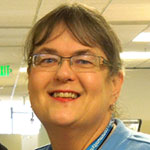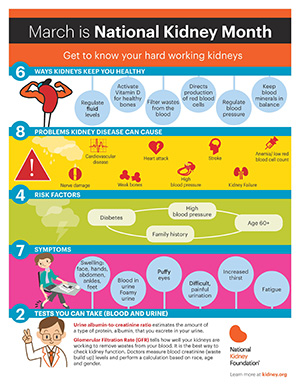Get to Know Your Hard-Working Kidneys

Knowing our bodies is important for our overall health and wellness, and this includes getting to know about our kidneys. The kidneys are two bean-shaped organs, each about the size of a fist. They are located just below the rib cage, one on each side of your spine.
Healthy kidneys filter about a half cup of blood every minute, removing wastes and extra fluid to make urine. They keep your body in balance, holding on to what your body needs and getting rid of what it doesn’t. By filtering the blood, they regulate fluid, important minerals, hormone levels involved in bone health and red blood cells, and blood pressure.
Kidney disease can put you at risk for other health problems, affecting different organs, including the heart (e.g., heart attack) and the brain (e.g., stroke). It can also put you at higher risk for infection.
When looking at the impacts of kidney disease, it is important to look at the numbers and data. These facts tell a story:
- One in three Americans are at risk for kidney disease.
- 37 million people have chronic kidney disease.
- 786,000 people live with kidney failure.
- 100,000 people are waiting for a kidney transplant.
For people living with kidney disease, treatments depend on the underlying cause of the disease. There are also general dietary and lifestyle changes, and medications that can help, such as a low salt diet and controlling blood pressure.
When kidney disease progresses to kidney failure, options include dialysis. Dialysis is the process of removing excess water, uremic solutes, and toxins from the blood in people whose kidneys can no longer perform these functions naturally. The first successful dialysis was performed in 1945. Sometimes dialysis is called kidney or renal replacement therapy but it’s important to remember that this process is not the same as having working kidneys.
There are three main types of dialysis—in-center hemodialysis, home hemodialysis, and peritoneal dialysis. Each type has pros and cons. It’s important to remember that if you choose a type of dialysis, you always have the option to change, so you don’t have to feel “locked in” to any one type of dialysis.
For some, a kidney transplant may eventually become an option, if they are well enough. Others will choose a pathway to slow kidney disease while forgoing dialysis—this is often considered for people who also have other serious illnesses.
Regardless of the pathway, it is normal to seek additional support to live well with kidney disease. Seeing the need for holistic support, the nonprofit Northwest Kidney Centers introduced the world’s first kidney palliative care program in 2017. The goal of the palliative care program is quality of life. Treating the whole person and not just the illness, the program includes support for the emotional, spiritual, and psychological aspects of disease through quality, holistic care. This includes helping people match the treatments they receive with what is most important to them, given their overall health. The kidney palliative care team comprises a doctor, nurse, and social worker, all specialized in palliative care for people with kidney disease, working in concert with the dialysis team.
According to the National Institute of Diabetes and Digestive and Kidney Diseases, Black, Indigenous and other people of color are at much greater risk of kidney failure than white people, due in part to higher rates of high blood pressure and diabetes. African Americans are almost four times more likely to develop kidney failure and, while they make up about 13 percent of the population, they account for 35 percent of the people with kidney failure in this country. Latinx and Indigenous peoples are also at greater risk. Consequently, Aging and Disability Services emphasizes outreach to people of color to improve access to health information and services. For more information, click here.
Take charge of your kidney health
Following are tips for protecting your kidney health:
- Meet regularly with your health care team. Stay connected with your doctor, whether in-person or via telehealth (phone or computer).
- Manage your blood pressure and monitor your blood glucose levels. Work with your health care team to develop a plan to meet your blood pressure goals. If you have diabetes, check your blood glucose level regularly.
- Take medicine as prescribed and avoid Non-Steroidal Anti-inflammatory Drugs (sometimes called NSAIDs) like ibuprofen and naproxen. Your pharmacist and doctor should know about all the medicines you take, including over-the-counter supplements.
- Eat right—fresh produce and less salt intake can help. Talk to your health care provider about what is best for you.
- Reduce stress and make physical activity part of your routine. Consider healthy stress-reducing activities and get at least 30 minutes or more of physical activity each day. If you carry excess weight, set a weight loss plan.
- Make time for sleep. Aim for seven to eight hours of sleep each night.
- If you smoke, take steps to quit.
Though it may seem difficult, small changes can go a long way to keeping you and your kidneys healthier for longer.
Dr. Daniel Lam, a nephrologist and palliative care expert at Harborview Medical Center (Kidney Clinic, Kidney Research Institute, and Palliative Care Outpatient Clinic) eloquently stated, “What matters most to patients is how to live well with the optimum quality of life, and that varies from patient to patient.” Learn more by reading “‘My Time to Live’: Through Novel Program, Kidney Patients Get Palliative Care, Dialysis ‘til the End” (KHN, 8/30/2021).
 Contributor Mary Pat O’Leary, RN, BSN, a senior planner with Aging and Disability Services, extends gratitude to Daniel Lam, MD who, in addition to work at Harborview Medical Centers, is a palliative care medical advisor at Northwest Kidney Centers.
Contributor Mary Pat O’Leary, RN, BSN, a senior planner with Aging and Disability Services, extends gratitude to Daniel Lam, MD who, in addition to work at Harborview Medical Centers, is a palliative care medical advisor at Northwest Kidney Centers.
This article originally appeared in the March 2022 issue of AgeWise King County.
![Aging & Disability Services for Seattle & King County [logo]](https://www.agingkingcounty.org/wp-content/themes/sads/images/seattle-ads-logo.png)
